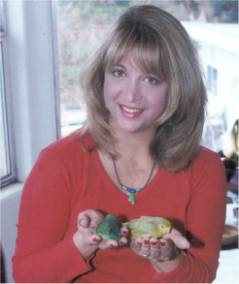Ms. Sandee,
On June 29, 2010, I purchase a blue male parrotlet (now named Jasper) at a Florida bird fair. He was born April 1, 2010. He has shown no signs of aggression. The only exception to this is his cage. Jasper must be out for me to put my hand in his cage to change or add something; otherwise he comes charging. My Green Cheek, Sydney, is also cage possesive.so this is nothing new. The exception to this aggression is coming out of his cage. Jasper then hops right on my hand ready to go. He also lets me rub his head some.
I respect his wishes if he does't want me to.
I also have a very gentle 5 yr old cockateil and a 1 yr old.mischievous but sweet Green Cheek Conure. I have all 3 birds out of their cages all the time and on me with no problems. I have been doing this since the quarantine was over. We do this everyday since I spend a lot of time with my birds.
There have been a few non serious swipes a couple of times among the three but nothing with intent to harm & no harm done. I immediately separate, discourage, scold, and stress not to get in the other's area. If I see one heading toward another's area, I immediately run interference. I might have one bird on one shoulder, another on my collar or neck, and one on the other shoulder or my head. Each is to stay in their own area. They also play on the table, bed or their cage tops with me supervising at all times.
I have recently read a few things that worry me concerning aggression in the parrotlet. My son warned me just today. His friend knew a parrolet that tore the beak off another larger bird. I do not want to be foolish and have someone hurt. Yet, Jasper has shown no aggression toward my establish flock.. I would appreciate it very much if you could please take the time to advise me. Thank you.
Betty
Dear Betty:
Thank you for your email. Your parrotlet’s behavior is very normal for a Pacific parrotlet. Almost all parrotlets are very territorial and aggressive around their cage. That is why it is so important to teach them the “Step Up” command as soon as possible so you can remove them from the cage before you have to service it.
Parrotlets are not domesticated birds like your cockatiel but are still very much wild and are guided by instinct. They are also not ‘flocking’ type birds like your conure. Parrotlets have a well-deserved reputation for not getting along with other birds. This is largely due to the fact that they originate in a very dry, desert-like region in which they have to compete for everything – food, shelter, nesting spots, etc. They are also very tiny and easily preyed upon by everything from reptiles to other birds; even spiders are bigger than they are so nature has designed them to be tough and aggressive in order to survive. These instincts do not change just because they are hatched in captivity and kept as pets.
However, unlike this story of a parrotlet biting off the beak of another larger bird, which, I have to admit after almost 30 years of breeding parrotlets, I find very difficult to believe, it is generally the parrotlet that is injured or killed when they attack another bird. A larger bird such as a conure can easily injure or kill a parrotlet in one bite should the parrotlet exhibit aggressive behavior. Indeed, lovebirds, which are not much bigger than parrotlets, often maim or kill parrotlets so both your cockatiel and your conure are a danger to the parrotlet rather than the other way around. It is because of the danger to themselves that I recommend species’ separation. They should never been kept in the same cage as other birds and should always have their wings kept clipped and only allowed interaction with other birds on a strictly supervised basis. Personally, I would never take the chance and would simply keep the parrotlet in its own space such as a basket or playpen and not allow it to have physical access to birds that exhibit more flocking behavior like conures and cockatiels both of which are much more social birds and do live very harmoniously with mixed collections. Parrotlets are just not built that way and for everyone’s safety should be kept physically separated. It isn’t hard to do – just keep everyone’s wings’ clipped and make sure the parrotlet has his own space to play and be active on.
I hope this helps!
Sincerely yours,
Sandee L. Molenda, C.A.S.
The Parrotlet Ranch, Owner, www.parrotletranch.com
Subscribe to:
Post Comments (Atom)




No comments:
Post a Comment
Note: Only a member of this blog may post a comment.